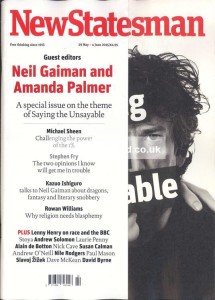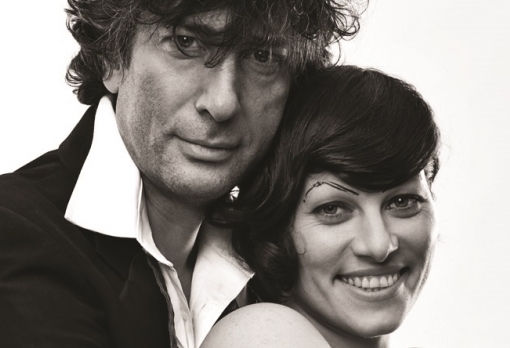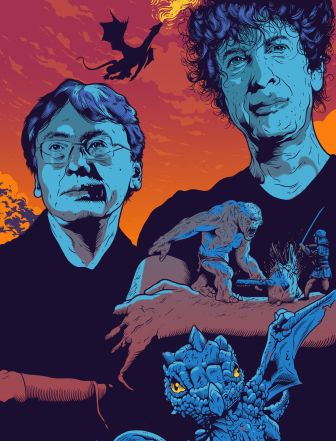Neil Gaiman and Amanda Palmer jointly edited the May 29 issue of the New Statesman, with the theme of “Saying the Unsayable,” focusing on free speech.
 Amanda Palmer’s “Playing the Hitler Card” calls for the end of online flame wars, saying “We live in an age of endless, foaming outrage. The only answer is to try to feel empathy for other people, no matter who they are.”
Amanda Palmer’s “Playing the Hitler Card” calls for the end of online flame wars, saying “We live in an age of endless, foaming outrage. The only answer is to try to feel empathy for other people, no matter who they are.”
There is also a feature on “Things You Can’t Say,” with contributions from Nalo Hopkinson and Laurell K. Hamilton.
The other highlight of the issue is an epic dialog between Neil Gaiman and Kazuo Ishiguro, “Let’s Talk About Genre” —
Neil Gaiman Let’s talk about genre. Why does it matter? Your book The Buried Giant – which was published not as a fantasy novel, although it contains an awful lot of elements that would be familiar to readers of fantasy – seemed to stir people up from both sides of the literary divide. The fantasy people, in the shape of Ursula Le Guin (although she later retracted it) said, “This is fantasy, and your refusal to put on the mantle of fantasy is evidence of an author slumming it.” And then Michiko Kakutani in the New York Times reviewed it with utter bafflement. Meanwhile, readers and a lot of reviewers had no trouble figuring out what kind of book it is and enjoyed it hugely.
Kazuo Ishiguro I felt like I’d stepped into some larger discussion that had been going on for some time. I expected some of my usual readers to say, “What’s this? There are ogres in it . . .” but I didn’t anticipate this bigger debate. Why are people so preoccupied? What is genre in the first place? Who invented it? Why am I perceived to have crossed a kind of boundary?
[Thanks to Martin Morse Wooster for the story.]
Discover more from File 770
Subscribe to get the latest posts sent to your email.



Thanks for the notification, Mike. This sounds very interesting.
I know Japan is a long way from North America, but Ishiguro is a professional writer with a long global track record. Does he truly say that he had no idea that “literature” sometimes looks down on “genre” writing? LeGuin has been writing about this for almost all my adult reading life, not to mention standing astride the “divide” for most of her career. (Sorry to litter the landscape with emphasis quotes, but I agree with LeGuin that many people see this divide as real. Me, I read what interests me and leave labels to others.) I plainly need to read the magazine …
Amanda Palmer’s “Playing the Hitler Card” calls for the end of online flame wars,
ObJonStewartObFoxNews: You know who wants to end flame wars? Hitler
Palmer’s article seems fantastically apropos here :-/
Ishiguro was born in Japan but grew up in Great Britain, where he has lived since age 5. one of his other books is The Remains of the Day, about as British a novel as there could be.
No comment on his understanding of the place of genre, just clarifying his background.
I years ago decided to make a strenuous effort to curb the wild typing fingers of my youth, because I foresaw this coming down the road like the brass band at the head of a parade on Broadway.
Usually it’s nifty and keen to look at the world, see the trends before you, and make an accurate prediction about the future, because that means, hey, I’m smart!
And there are times when I am not happy that I looked at the world, saw trends before me, and made an accurate prediction, because it meant, hey, I’m Cassandra, and Lazarus Long said I didn’t get the ass-kicking I deserved.
This is an occasion of the latter:
http://popehat.com/2015/06/08/department-of-justice-uses-grand-jury-subpoena-to-identify-anonymous-commenters-on-a-silk-road-post-at-reason-com/
Except maybe for Buried Giant which is even Britisher!
It’s interesting to me that Buried Giant is hardly in a unique situation genre-wise. The ‘literary’ shelves in my library and book store have plenty of books with fantastic or science-fictional elements (especially fantastic). Richard Adams’ Shardik is there, all of Angela Carter, Erin Morgenstern’s Night Circus. If Ishiguro hadn’t said anything, I’m sure his choice would have passed unnoticed. So is there a valid difference? To me as a reader, none. I pick freely from the more literary side of the fantasy shelf and the more fantastic side of the literary shelf. They appear to me to be the same kind of books. But as everyone knows, this year’s Hugo Award is marked by a subset of people taking a firm stand against the very type of book I usually choose. They would apparently like to expel the whole lot from the field, even as Le Guin berates the writer of one such book for declining to grace SFF with his presence.
Non-puppy types might also have noticed that writers of color are especially likely to end up in the literary shelves, for a bunch of reasons. When I saw so much interest in diversity and voices from a variety of cultures at Loncon I suspected that whole boundary was likely to be eroded. For myself, I would call my writing magical realism (of a decidedly multicultural type and complete with dragons!) but I’d thought I might be able to throw my lot in with Fantasy quite comfortably. Now I see that my kind of writing is also very vocally Not Wanted by a sub-group. Does anyone else think this might play into writers future choices about positioning? It’s certainly an awkward situation for books that straddle the genre edge. Buried Giant isn’t your regular kind of genre fantasy – nothing to do with its quality or interest, it just isn’t.
The cover for the Gaiman/Palmer issue was originally drawn by Art Spiegleman (of MAUS fame). He withdrew it from the NEW STATESMAN just before publication as retaliation for the publishers going back on their word to print a comic strip he drew about the CHARLIE HEBDO incident in the issue. The editors objected, but the publisher refused to publish the strip. So Art withdrew his cover.
Ironically, the cover art was about censorship and freedom of expression. *sigh*